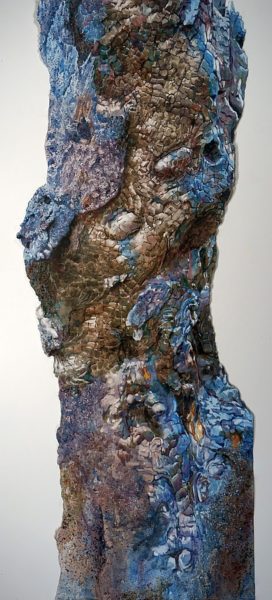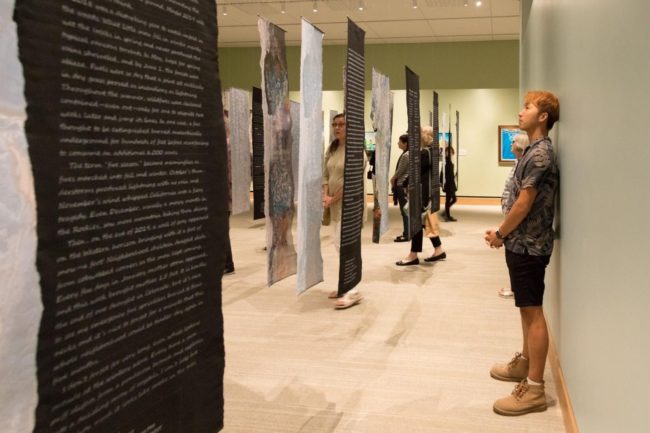I have been painting portraits of individual burned trees for the last eleven years. A landscape painter and lifelong outdoor person, in the last twenty years I have seen my local glaciers shrink and more and more burned-over areas appear. My home state of Washington reported the largest wildfire in its history – for three years running (1)!
Everywhere I travel in the North American West for artist residencies in art colonies and national parks, I find the same phenomenon. As noted fire ecologist Stephen Pyne says, “Winter isn’t coming. Welcome to the Pyrocene” (2).
At first I painted those altered scenes as entire landscapes:



Then close-up studies of individual trees became my metaphor for our predilection for cooking the planet. Yet for all my fear, anxiety and grief, I also see unusual beauty. Wildfire fighters call fire-carved standing snags “totems:” in some ways they all the same – carbonized, eaten away; yet each one is different – the fire’s physics and the tree’s biology create unique sculptures. Each ridge and fissure becomes a landscape unto itself. Char remains iridescent for up to a decade, reflecting local light and color.
In formal terms, I have come to appreciate how many organic processes leave evidence of both internal structure— the lignin and cellulose that form intricate

layered compartments – and randomness – slight variations in their shapes and volumes – which result in complex and compelling textures, like topographic maps writ small. I’m aware that they exert a special fascination for me, like neurons that fire without my conscious control.
The size of each tree paintings is large enough to make them harder to ignore. It is my hypothesis that when wall-mounted artwork approaches body size (even if it is not as large as the actual tree), we respond more viscerally than if it were smaller. Our bodies contribute to our emotional reaction as well as our minds.
I wanted to make a stronger impression than a large painting on a wall. I was inspired to create a three-dimensional installation that would evoke the feeling of walking through a burned grove, not only for people who might not have seen one, but in a form and location that would set the experience apart.
State of the Forest contains 30 of my paintings printed on fabric cut to the shape of the tree. Each set contains three layers: a transparent print, a solid print and a black layer. Together they create a tree volume, if not in its usual cylindrical form.

Staggered views of the sets recapitulate the “picket fence” sensation of seeing the closest trunks as stationary and further rows appearing to move as you do. The transparent layer provides a video-like experience as the viewer walks by, seeing moiréed multiples.
Fourteen of the black layers have texts written by wildland firefighter and author Lorena Williams (3). These stories, essays and poems pertain to the individual tree, noted on each by title, species, location, fire and year.

Since each tree originated in a different location, the grove is a composite emblem of all recent forest fires. While there are multiple causes of such catastrophic fires, including previous forest management policies and the growing number of wildland-urban interfaces, climate change is responsible for more than half of them, with a six-fold possible increase facing us in the future (4).

These ethereal volumes suggest that our perceptions of forests as permanent and unchanging are mistaken—in fact they are fragile and greatly impacted by human activity. I am deeply gratified to see installation viewers pausing to consider the artwork and its messages.
References:
- Washington State Department of Natural Resources, as reported by KXLY https://www.kxly.com/news/wa-state-has-a-wildfire-crisis/979644062
- https://historynewsnetwork.org/article/172842
- https://sites.google.com/site/lorenalwilliams/
- “By 2100, annual acreage burned by wildfires could increase by as much as 6 times in some places.” Fourth national climate assessment https://nca2018.globalchange.gov/chapter/6/
- http://www.suzewoolf-fineart.com/index.php/galleries/burnscapes/211-state-of-the-forest-installation
- https://www.davidjwagnerllc.com/Environmental_Impact-Sequel.html
- https://thejamesmuseum.org/
Suze Woolf studied ceramics and printmaking at the University of Washington. An early adopter of computer graphics, her career has included print and interface design. Though known as a watercolorist, she explores a wide range of media from painting, paper-casting, artist books and pyrography to installation – sometimes all together.
She has exhibited throughout the Pacific Northwest but also in Utah, British Columbia, Maryland, California, Colorado, Oklahoma and Washington DC. Her work is in regional public collections as well as many private ones. She has curated a large travelling exhibit, juried competitions for municipalities and artist organizations, and contributed work to non-profit fundraising.
She has received grants, stipends and exhibits from Artist Trust, Shunpike, The Entrada Institute, Zion Natural History Association, the Museum of Northwest Art and the San Juan Islands Museum of Art. She has been artist in residence in Zion, Glacier, Capitol Reef and North Cascades National Parks. She was a test artist resident at the Grand Canyon Trust’s remote Kane Ranch. 2019 will be her seventh year in Zion’s annual plein air invitational. She has also been an invited resident at art colonies such as the Banff Centre, the Vermont Studio Center, Willowtail Springs, Jentel Foundation and Playa Summer Lake.
Website: www.suzewoolf-fineart.com
Blog: https://suzeart.wordpress.com/
The MAHB Blog is a venture of the Millennium Alliance for Humanity and the Biosphere. Questions should be directed to joan@mahbonline.org.
The views and opinions expressed through the MAHB Website are those of the contributing authors and do not necessarily reflect an official position of the MAHB. The MAHB aims to share a range of perspectives and welcomes the discussions that they prompt.

